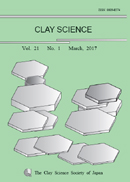
- Issue 4 Pages 63-
- Issue 3 Pages 41-
- Issue 2 Pages 21-
- Issue 1 Pages 1-
- |<
- <
- 1
- >
- >|
-
Kiyonori Takahashi, Ryo Ishii, Asami Suzuki, Takashi Nakamura, Manabu ...2017Volume 21Issue 1 Pages 1-6
Published: March 31, 2017
Released on J-STAGE: June 16, 2017
JOURNAL FREE ACCESSLignin–montmorillonite nanocomposite films have been prepared in order to elucidate the possibility for flexible substrate film of electronic devices. The prepared films possessed multi-layer stacking structure having intercalated lignin between nanosheets of silicate. They showed 18–57 g m−2 day−1 of water vapor transmission rate and 6–7 ppm K−1 of linear coefficient of thermal expansion after annealing up to 503 K, superior to the characters of the industrial polyimide film. The characteristics are originated from the clay mineral that has high aspect ratio silicate structure and the difference in water vapor penetration was derived from hydrophilicity of polymers. Although arithmetical mean roughness, Ra, was under 0.3 µm by AFM, the films were followed by drawing electronic wiring using Ag ink, resulting in the good formation of printed circuit due to the compatibility of the ink to the substrate material. Consequently, we found that lignin–montmorillonite nanocomposite films are applicable for the substrates of electronic devices.
View full abstractDownload PDF (831K) -
Kazuhiro Shikinaka, Kazuto Aizawa, Kiyotaka Shigehara2017Volume 21Issue 1 Pages 7-12
Published: March 31, 2017
Released on J-STAGE: June 16, 2017
JOURNAL FREE ACCESSIn this study, further improvement in the mechanical strength and structural ordering of hybrid films consisting of poly(ethylene glycol)-modified Laponite® RD was achieved by cross-linking via the methacrylate groups at the end of the poly(ethylene glycol) strands. Because of cross-linking between the polymer strands via the methacrylate groups, the hybrid films presented here exhibited better mechanical properties and higher ordering of Laponite® RD platelets than other hybrid films consisting of poly(ethylene glycol)-modified Laponite® RD. The hybrid films are transparent and flexible, and show fire-shielding properties. Thus, they have potential applications in various industrial fields.
View full abstractDownload PDF (720K) -
Teruyuki Nakato2017Volume 21Issue 1 Pages 13-20
Published: March 31, 2017
Released on J-STAGE: June 16, 2017
JOURNAL FREE ACCESSColloidal nanosheets are obtained by exfoliation of inorganic layered crystals such as clay minerals in water. They form colloidal liquid crystals at high nanosheet concentrations due to their shape anisotropy. Liquid crystalline nanosheets can be aligned under external fields. For this purpose, electric field is advantageous owing to its facile instrumentation, controllability, quantitative reproducibility, and broad applicability. AC electric field is utilized for aligning liquid crystalline nanosheets because the samples are aqueous colloids of electrically charged particles. The 2D shape of nanosheets facilitates alignment of their longitudinal direction parallel to the electric field in many cases. When a colloid sample is incubated to grow liquid crystalline domains up to the size of sub-mm scale, hierarchical macroscopic structures are evolved under electric fields, where the grown domains play a role of secondary building blocks. The final structure varies depending on the relative direction of applied electric field and gravity. An electric field applied parallel to gravity gives a net-like assembly of the nanosheet domains, whereas orthogonal application of an electric voltage and gravity assembles nanosheets in stripes spanning over more than 1-mm length through unidirectional nanosheet alignment. Such flexible organization of nanosheet-based structures is a unique aspect of exfoliated nanosheets in colloidal liquid crystalline states.
View full abstractDownload PDF (937K)
- |<
- <
- 1
- >
- >|